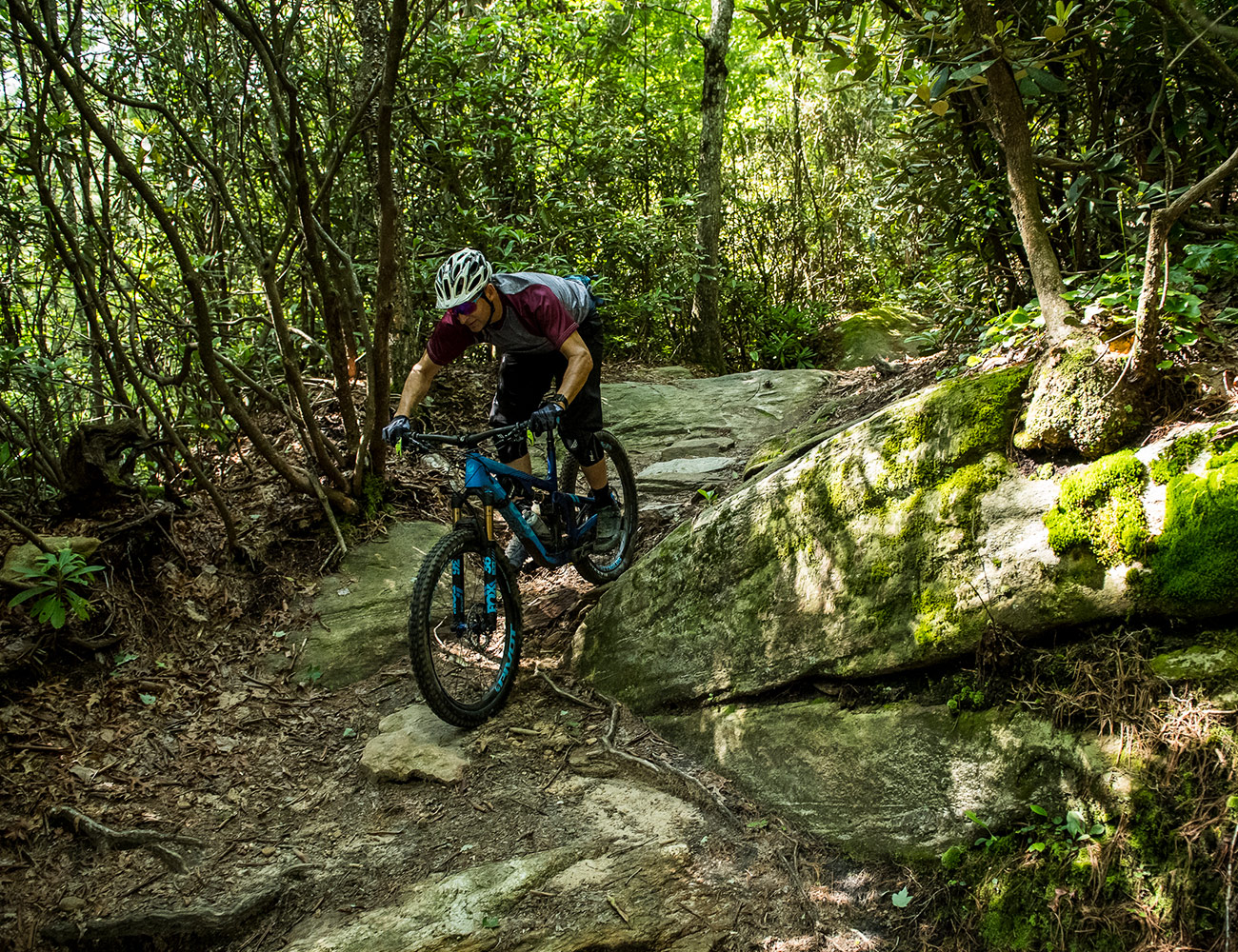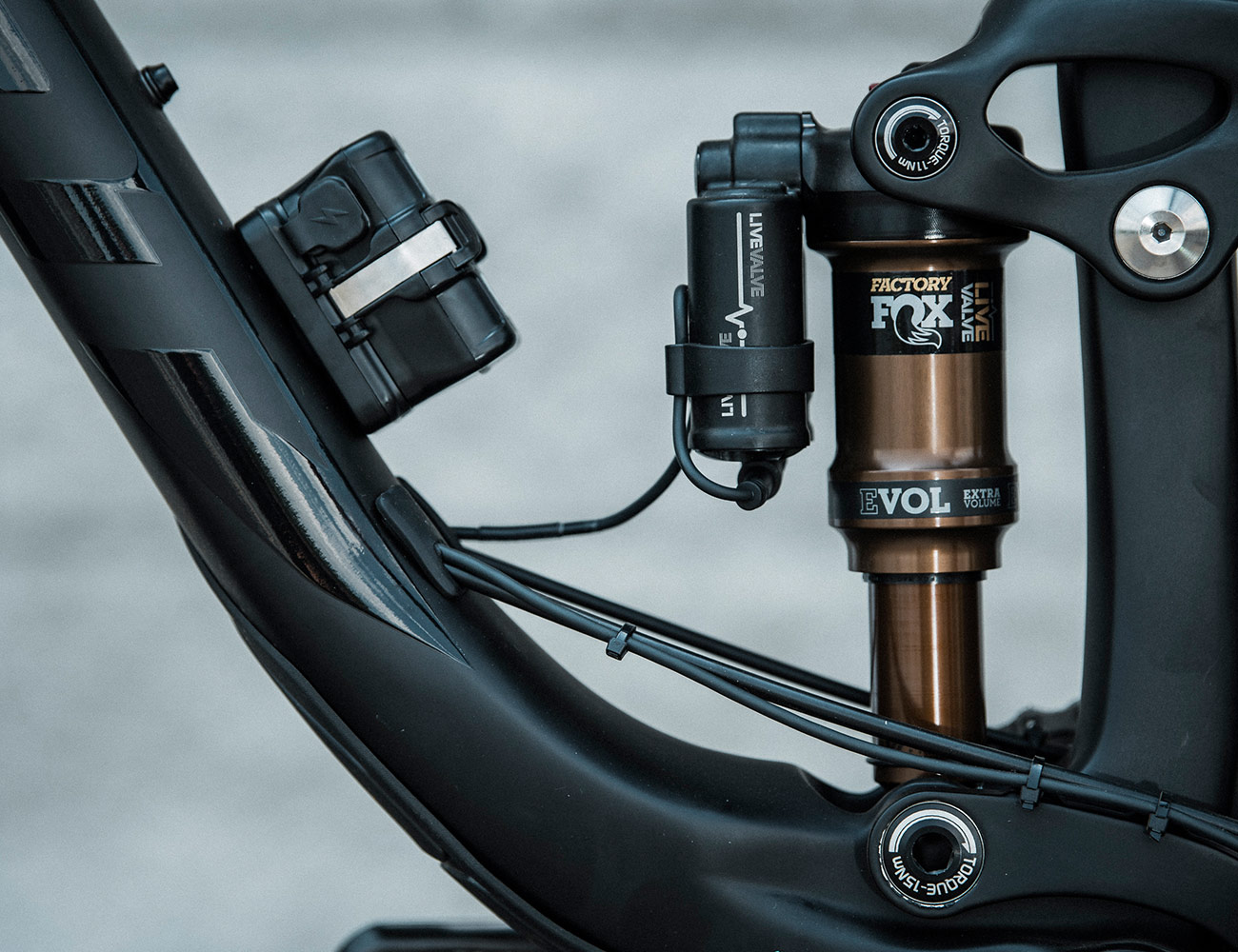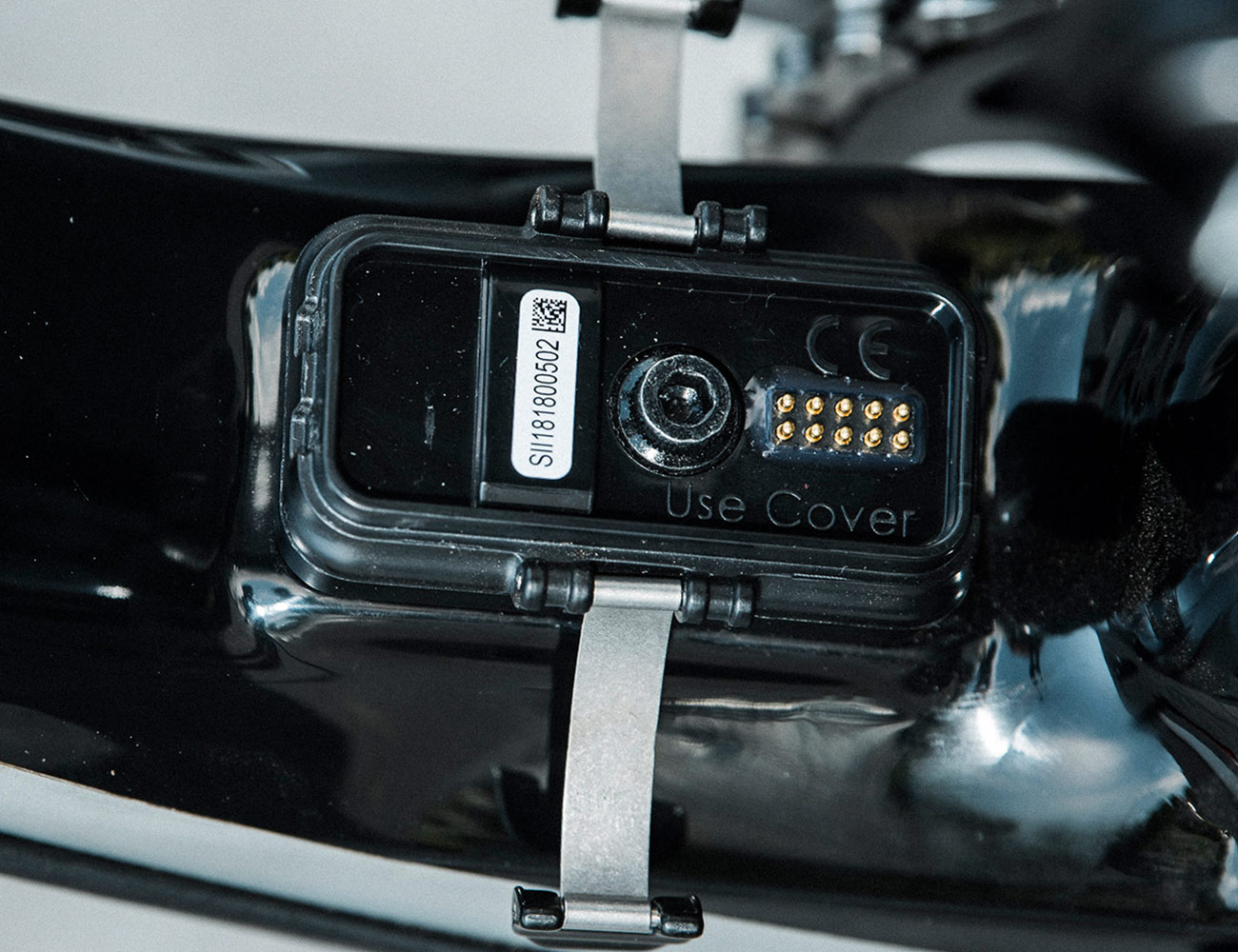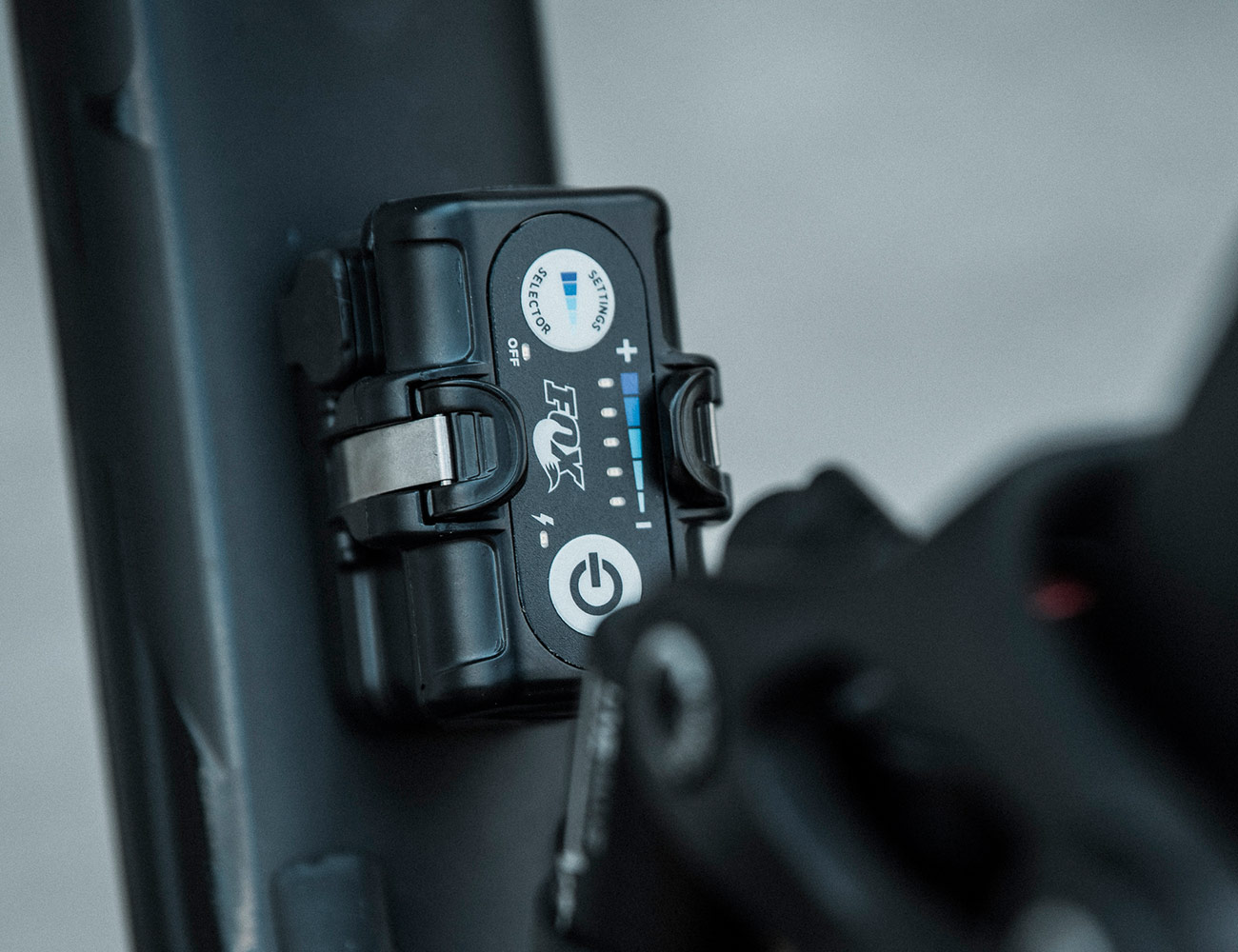If you ride your mountain bike somewhere the terrain is constantly changing, dipping and climbing, dropping and punching uphill, Fox’s new Live Valve system is going to make your ride better. The electronic system opens and closes your shock and fork 100 times faster than a blink automatically, switching from open to closed independently as the terrain changes. With the system turned on, sensors read the terrain and the position of your bike in that terrain 1,000 times per second. When it senses a bump, it opens your suspension before that bump can be translated through the bike, to the handlebar and to you. On average, the system opens and closes suspension around 450 times per hour.
The Good: On my home trails, I find myself constantly flipping the climb/trail/descend switch on my rear shock for pedaling efficiency. It’s a 1,000-foot climb from the road to the trails at my home network. But the path up is crisscrossed and scattered with obstacles. The downhills also have uphills. I don’t usually mess with fork settings unless I am on a long road pedal between networks. But I constantly flick my rear shock between open and trail mode, at the same time trying to avoid clipping a tree with my bars, or bouncing off as my wheel strikes a rock.
With Live Valve on, I never had to think about changing my settings, I just focused on the trail, and the system did the work for me. Instead of slamming into a square-edged rock climbing with my shock locked, the system opened my locked-out shock and fork for a split second to absorb the bump in the road. On technical descents, Live Valve made landings as absorptive as possible, and adjusted to smooth out the trail whether I was bombing down a gulley, rolling a steep rock, or cruising flowy packed dirt.

I tested Fox Live Valve on a 27.5″ wheel Pivot Mach 5.5, a 140mm rear travel, 160mm front travel trail/enduro bike with wide 2.6″ tires. My first test was in Brevard, North Carolina, where I rode The Mach 5.5 with Live Valve on the slippery, rocky trails of Brevard as well as in sandy, rooty Dupont State Forest. Then I rode the Pivot 5.5 with Live Valve for four months on the steep punchy climbs, sometimes flowing sometimes jolting descents and matted roots of Vermont. Live Valve made riding the Pivot more efficient and more fun than it was to ride it with Live Valve turned off, or without the Live Valve system and manually adjusting the bike’s suspension.
With Live Valve, the front and rear shocks are adjusted independently. 90 percent of the time the shock opening is triggered by a signal from the fork, but if you’re manualing with your front wheel in the air, if you hit your rear wheel on a bump or obstacle, the system will activate from the rear. Pitch detection lets Fox decouple the front end from the rear so that a front impact doesn’t necessarily open the rear.
The system is agnostic as to what kind of bike it’s on — from XC to DH. The bike manufacturer has the final say on how Live Valve locks out or not. It’s totally tunable — bump threshold, timer and incline angle are all adjustable. But for now, only the bike manufacturer can control it, and there’s no plan to make tunability available to consumers.
Fox admits that no system is idiot proof, but the weak point in this system is comparable to what can go wrong on any bike. The rider can set their shock with the wrong pressure, tweak rebound settings to be too soft or too harsh, or can set the system to its extreme, which prevents the shocks from engaging except during the most extreme riding.
Who It’s For: Fox Live Valve is for any rider who switches their shock from open to trail or closed during a ride. Fox Live valve constantly adjusts your front and rear suspension settings when you’re climbing smooth trail, pushing up a rocky obstacle, descending, hucking, cornering and more. If you want your bike to do everything more efficiently, and with less bobbing around, this system is for you. Also, if you’ve ever locked out your suspension while you’re climbing, then wondered why the downhill was so jarring, answer: you forgot to open your suspension up before descending — Live Valve solves that problem.
Watch Out For: It’s an electronic system, which means you need to charge it every 16-20 hours according to Fox, which we found to be pretty accurate. If you forget to charge the Live Valve battery, you can postpone your ride slightly — the system takes 2.5 hours to fully charge, in 15 minutes you can juice up the battery enough for a two-hour ride. And if you do lose power during a ride, your suspension defaults to open, so it’s not the end of the world.
If you’re already running Di2, and you also run Live Valve, you’re going to have a lot of batteries strapped to your bike. Live Valve and Di2 cannot currently be run off the same battery.
Alternatives: Specialized and LaPierre both had systems that supposedly tuned suspension on the fly, but the Specialized system worked marginally, and the LaPierre system tuned the fork only not the fork and shock. There isn’t anything else on the market that effectively opens and closes the oil paths in a bike’s fork and shock in response to terrain and that helps all riders, regardless of skill, ride better. Prototypes of this system have been around for several years, but this is the first time Live Valve is available on a bicycle. For 2019, Fox also makes Live Valve for Ford Raptor Trucks, and for Polaris side by sides.

Review: Despite the popularity of Di2 electronic shifting, a booming e-bike market, sensors in our phones and on our handlebars to record our speed, heart rate and distance, some riders still wonder if electronics belong on mountain bikes. We think they do, when those electronics let us do things we can’t do mechanically in order to help us ride better and faster while having more fun. Live Valve makes any mountain bike more efficient and easier to control, and it prevents human error by always opening up your fork and shock on the downhill.
The components of Live Valve include a controller, battery, sensors, a latching solenoid that controls oil in the shock and fork cylinders and Fox’s algorithm, which controls how the data collected by the sensors opens and closes your suspension. The battery toggles the solenoid inside your shock and fork, opening and closing your suspension in a 25-millisecond pulse from the battery. Sag, your high and low-speed compression and rebound are set the same as with any other bike suspension setup. The system works the same in all Fox shocks and forks — only the valving is different.

The frame-mounted controller holds a microprocessor and it allows the rider to turn the system on and off, and choose how completely the shock is open. Front and rear accelerometers measure gravity, and determine if the bike is going up, down or if it’s on flat ground.
A two-cell lithium-ion 7.4v 800 mAh battery powers the system. It can be removed for charging or can be charged on the bike via a standard micro USB cord.
Turn the system on by pressing the power button on the controller, and green LED lights illuminate to let you know that the system is active and indicate which of the five settings you’re in. A button above the power lets you toggle between settings. And when you press the power a second time, the system gives a red light and turns off. If you forget to turn the system off after your ride, it won’t drain the battery. If the controller doesn’t detect a bump for 1.5 hours, the system shuts down automatically, saving your settings and your battery.

The five setting modes let you choose how big of a bump it takes to open up your shocks and how long your shocks stay open. Once you’ve chosen a mode, front and rear accelerometers read the terrain 1,000 times per second, recording acceleration from bumps and jumps 100 times faster than a blink, as well as detecting pitch. So Live Valve knows if you’re pedaling uphill or downhill, freefalling or traversing, and whether the terrain is bumpy or smooth. Every 1,000th of a second it determines your optimal suspension settings. When the front sensor detects bumps of a certain magnitude, it opens the front suspension and starts a half second timer. If the timer runs out and there are no more bumps detected, the system closes your suspension. If the front sensor detects another bump before the timer runs out, it resets the timer for another half second. If the timer ever expires as you throttle down a long rocky trail, the battery has only powered one opening.
It’s possible to crash and break a wire. And though mud, grime and water won’t affect the sensors or the system’s connectors, which look something like a headphone jack cord, they could, in theory, pop out. Unlike the Di2 system, which recommends a dedicated tool to reconnect finicky wires, the Fox Live Valve connectors can be quickly and easily reconnected or replaced.
And if you’re washing your muddy bike and leave the battery hatch open, and jam dirt into it or jet water into it, you could ruin the battery. Fox recommends not pressure washing the system — much like bike manufacturers recommend not pressure washing your bike at all. The system is rated to IPX 7, one of the most aggressive standards for water intrusion, which means you can submerge it in a meter of water for 30 minutes.
Verdict: I went into testing this system skeptical, and after riding it for four months, I wish I had it on all our bikes. It feels like a genie that knows your thoughts before you do, and that adjusts your bike’s suspension so that you can sail through your favorite trails with maximum enjoyment and minimal jolting.
Key Specs
Price: Add Live Valve to a bike from Rocky Mountain, Pivot, Giant or Scott and it’s $3,000 — if you’re running a 32 Step Cast or 34 fork. $3,125 for a Step Cast 34, and $3,250 for a Fox 36. Buy a bike with the system from Pivot, Scott or Giant, and you’ll pay around $1,800 more — similar to the cost of Di2 when it was introduced.
Fork Compatibility: Fox 32 and 34 Step Cast, Fox 34 and Fox 36 forks are all compatible
Weight: Just shy of two pounds. 72 grams for the battery, 104 grams for the controller and sensors, 466 grams for the Live Valve shock modifications and 249 grams for the damper. In total, it’s around 5 ounces heavier than Scott’s Genius cable-activated lockout.
Warranty: Fox’s warranty will be the same as on its other products — one year in the US and two years in Europe.
Hot takes and in-depth reviews on noteworthy, relevant and interesting products. Read the Story




